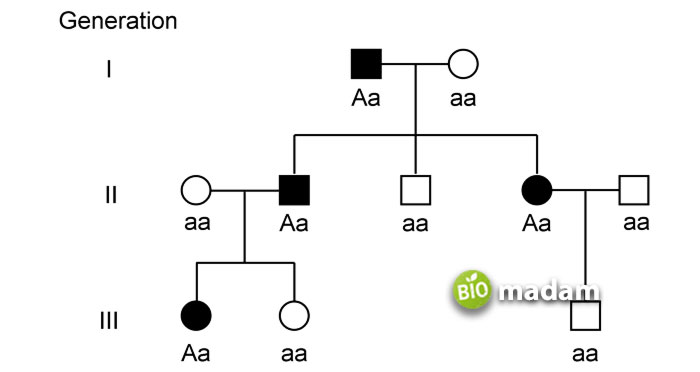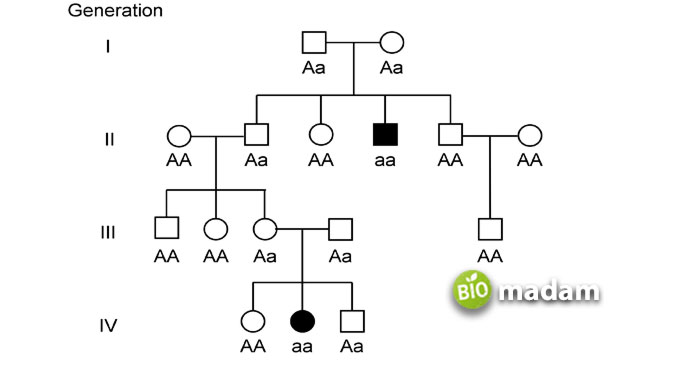DNA and genes are the most important part of reproduction. Genes and alleles carry the characteristics of an organism to the off-springs through replication and division. The characteristics are exhibited on alleles. Some features may be dominant over others. If two parent cells have different alleles, the dominant will show in the daughter cells.
Let’s tell you all about alleles and the differences between dominant and recessive alleles.
Comparison Table
| Characteristics | Dominant Allele | Recessive Allele |
| Expression | Homozygous and heterozygous | Homozygous |
| Representation | 75% | 25% |
| Denoted by | Capital letters | Small letters |
| Type of Character | Dominant characters | Recessive characters |
| Type of Traits | Superior | Inferior |
| Disease Causing | High chances | Low chances |
| Example | Right-handedness | Left-handedness |
What are Alleles?
Alleles or allelomorphs are defined as one of two or more versions of the DNA sequence on a genomic location. They may occur in pairs of multiple alleles representing the genotype and phenotype of a particular trait. Every individual receives two alleles from each parent. The alleles may be the same or different. When the individual gets the same allele from both parents, they are homozygous for that allele. On the other hand, if they receive different alleles for the same characteristic, they are heterozygous. Sometimes, the alleles may exhibit codominance or incomplete dominance as well.
What are Dominant Alleles?
As the name indicates, dominant alleles are the dominant gene variant that determines the daughter cell phenotype. They are the strongest alleles among the different forms of genes in the same loci. Often the dominant alleles are found in most of the population living in different biodiversities. However, sometimes, the dominant characteristics may not appear in the majority of organisms of that population. Typically, dominant genes carry better characters, but it may not always be true.

Example
The most common example of a dominant allele is the human eye color. Let’s take the example of brown and blue eye color. Around 70 – 80% of people in the world have brown eyes, while 8 – 10% of the human population has blue eyes. Why is that?
Brown eye color is the dominant allele exhibited by B. Alternatively, the recessive eye color blue is represented by b. If one of your parents has homozygous brown eye alleles (BB) and the other has homozygous blue allele (bb), all their children will have heterozygous brown eyes (Bb). It is because brown dominates blue.
However, sometimes you might be surprised to see blue-eyed children of brown-eyed parents. No, it does not negate the dominant and recessive allele theory. It happens because one of their grandparents might have been blue-eyed. Their parents received Bb from their grandparents. Thus, the combination of Bb (parent 1) and Bb (parent 2) gives BB, Bb, Bb, and bb. Eventually, 25% of their off-springs have a chance to be blue-eyed.
Dominance works through the generation; you can understand the patterns by studying previous generations.
What are Recessive Alleles?
Recessive alleles are the weaker among the different alleles of a gene. It expresses only if the off-spring received homozygous alleles from both parents. As the dominant alleles mask the recessive allele in heterozygous situations, they do not exhibit their characters. They are represented by small letters ‘a’ in contrast to dominant alleles ‘A.’

Example
The examples of dominant alleles also exhibit recessive alleles. You can find different representations of recessive and dominant alleles in humans, animals, plants, fungi, etc. But let’s have a look at an example of the fur coat in animals.
Animals receive the color of their fur from an allele that controls melanin production. Melanin is also present in humans to determine skin and hair color in humans. The recessive allele for melanin produces an enzyme that does not contribute to converting the intermediate molecule.
Black rabbits with a heterozygous dark melanin gene have a 25% chance of having a lighter coat. While black is a dominant allele, white rabbits have a higher chance of reproduction. So, the population of white rabbits increases in biodiversity.
Similarities Between Dominant and Recessive Alleles
- Dominant and recessive alleles encode for a trait.
- They are present at the same locus of each gene.
- They exhibit their respective phenotypes in the homozygous state.
Difference between Dominant and Recessive Alleles
Definition
Dominant Allele
The dominant allele is the respective gene that exhibits a heterozygous state.
Recessive Allele
The recessive allele, on the other hand, is the gene on the locus that only expresses in the case of homozygous alleles.
Type of Characteristics
Dominant Allele
The dominant allele determines the dominant character in a population.
Recessive Allele
On the contrary, the recessive allele represents the recessive character in the population.
Denoted By
Dominant Alleles
Dominant alleles are represented by capital letters like ‘T,’ ‘B,’ etc.
Recessive Alleles
In contrast, recessive alleles are denoted by small letters such as ‘t,’ ‘b,’ etc.
Representation
Dominant Allele
Dominant alleles are more frequent in organisms of the population, accounting for around 75%.
Recessive Alleles
Whereas recessive alleles are less frequently found than dominant alleles in most populations.
Characters
Dominant Alleles
Dominant alleles typically carry the better characteristic.
Recessive Alleles
At the same time, recessive alleles generally have inferior characters.
Phenotype Expression
Dominant Alleles
Dominant alleles exhibit their characteristics in homozygous as well as heterozygous states.
Recessive Alleles
However, recessive alleles express themselves only in homozygous conditions.
Disease-Causing
Dominant Alleles
Dominant alleles are more prone to producing genetic diseases and disorders in daughter cells.
Recessive Alleles
Recessive alleles are less likely to pass on chronic conditions or diseases to the off-springs.
Examples
Dominant Alleles
Examples of dominant alleles in humans include brown eyes, detached earlobes, and right-handedness.
Recessive Alleles
Similarly, blue eyes, attached ear lobes, and left-handedness are examples of recessive alleles.
The Bottom Line
Dominant and recessive alleles are major components of different types of chromosomes in living organisms. They are responsible for giving unique characteristics to each individual. The set of different alleles and their representation differentiates one individual from the other. Dominant alleles express in both homozygous and heterozygous states. However, recessive traits do not exhibit in the heterozygous state. For example, brown eye color in humans is an example of a dominant allele in which blue eyes result from homozygous recessive alleles.
FAQs
What is dominant and recessive with examples?
Dominant alleles exhibit themselves in homozygous and heterozygous states, while recessive alleles show only in homozygous conditions. Tallness in vascular plants is a dominant allele compared to the allele for short height.
How do you determine if a gene is dominant or recessive?
Genotypes that are directly passed on from parent to the children, through mitosis, are typically dominant. Recessive alleles may skip generations and exhibit when homozygous situations arise.
Is dark skin dominant or recessive?
Skin does not have only two shades. Thus, it is neither a dominant nor recessive trait. Heterozygous alleles for skin color exhibit incomplete dominance. They control skin color by increasing or decreasing melanin production.

Jeannie has achieved her Master’s degree in science and technology and is further pursuing a Ph.D. She desires to provide you the validated knowledge about science, technology, and the environment through writing articles.

